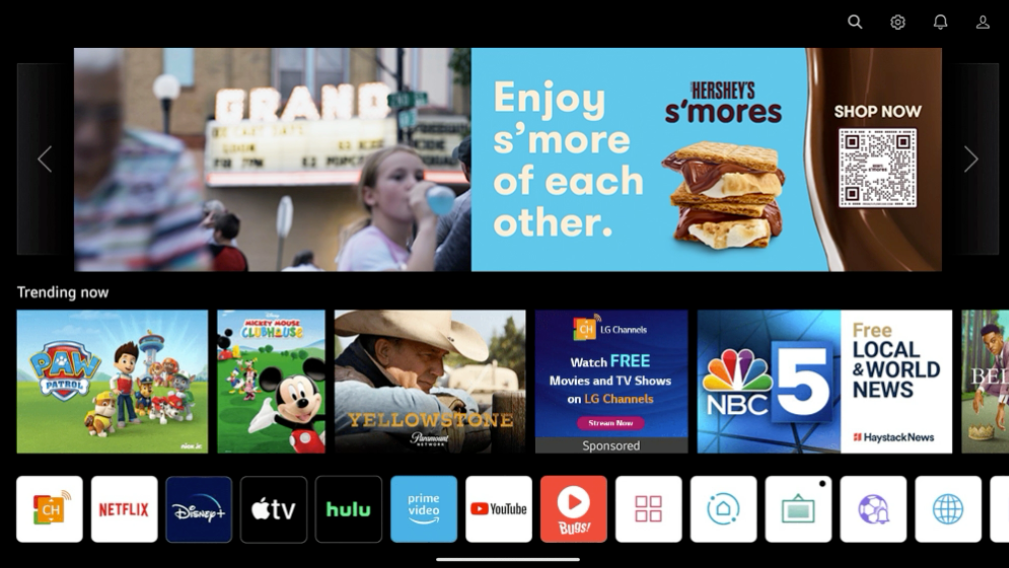Hershey Has S’more Success With Ads on LG Home Screen
Connected-TV execution draws high recall scores

No matter what you’re going to watch, you’re going to want some chocolate.
So it makes sense that Hershey, a longtime television advertiser that has already shifted most of its video budget to streaming and connected TV, was willing to try putting ads directly on the home screen of LG smart TV sets.
”We are a fairly significantly large category,” Vinny Rinaldi, head of media and analytics at Hershey, told Broadcasting+Cable. “Penetration on candy, mints and gum is 98% and chocolate makes up 75% of that. So really for us, we want to speak to everyone with a mouth and/or stomach.”
Rinaldi said he doesn’t like to differentiate between linear and streaming video. To him, what matters is that Hershey’s shows up on TV sets.
“The reality is it’s still the biggest screen in the home and we want to be on that, as a chocolate brand, across our portfolio of products because it resonated the most and has the greatest impact to our business,” he said.
Hershey has been working with Kargo, an ad-tech company that started in mobile and has shifted into connected TV, for about seven years. An early interactive campaign let users smush a virtual s’more on their smartphones.
S’mores are a big deal at Hershey, because it’s a big family moment, just like when families sit down to watch a movie together.
Broadcasting & Cable Newsletter
The smarter way to stay on top of broadcasting and cable industry. Sign up below
“We want to own the campfire. You can’t do s’more without chocolate, period. End of story,” Rinaldi said. “And why wouldn’t we want to be the only chocolate brand you choose to put between two graham crackers and find that moment?”
Working with Hershey media agency Horizon, ads pushing Hershey’s S’mores started running on LG home screens, which means viewers saw the ad when they turned on their TVs, even before they picked what they wanted to watch.
“This was a seamless execution to show up on the big screen in a very high-impact environment,” Rinaldi said.
LG offered several home-screen executions. In one, the Hershey’s S’mores ad took up a slice of the home screen. Another execution, in which the ad was a part of the carousel of programming choices, was the most effective, according to Rinaldi.
“All of them had a good audience reaction, but I love the carousel unit the most because it almost feels like you're taking over the whole screen,” he said. “People's screens in their homes are getting bigger and bigger as well, so the more landscape that we can take up on a single screen, the better for us.”
Testing new approaches is important in an evolving TV advertising environment, Rinaldi said.
“I am a firm believer that a portion of our budget should always be geared towards new tactics,“ he said. “They are going to fail and they’re going to be successful, and I think that’s OK. The more we can learn from it and pivot and optimize, the better for the long haul we’re going to be as a brand.”
LG, with 33 million TV sets in more than 10 million homes provided enough scale for a meaningful test, Rinaldi said.
This campaign proved successful. Hershey’s research found a recall rate of 77%. People who saw the ads said the ads made them think of moments of goodness like family fun and creating warmth.
In the chocolate category, sales happen overnight, but recall and building the brand is important.
The campaign also produced sales. “This was a revenue-driving tactic without a doubt,” Rinaldi said. “We likely will be doing this again.”
Rinaldi declined to say how much the on-the-glass ads cost, but said they weren’t as expensive as 30-second spots, particularly on CTV.
“This is a place where you can get a multiplier effect on the money you’re spending on this,” he said.
Doing a similar campaign with other set makers might be tricky. The other set makers aren’t as geared towards selling special units as part of a larger buy as LG has been, according to Rinaldi.
Hershey will continue to look for high-impact video executions.
“Every screen is becoming much more connected and the ability to control a household across multiple units is going to be really important,” Rinaldi said. “And our brand may not react the same as others, but chocolate and candy look really nice on an 85-inch screen in the middle of a house.”
Jon has been business editor of Broadcasting+Cable since 2010. He focuses on revenue-generating activities, including advertising and distribution, as well as executive intrigue and merger and acquisition activity. Just about any story is fair game, if a dollar sign can make its way into the article. Before B+C, Jon covered the industry for TVWeek, Cable World, Electronic Media, Advertising Age and The New York Post. A native New Yorker, Jon is hiding in plain sight in the suburbs of Chicago.

